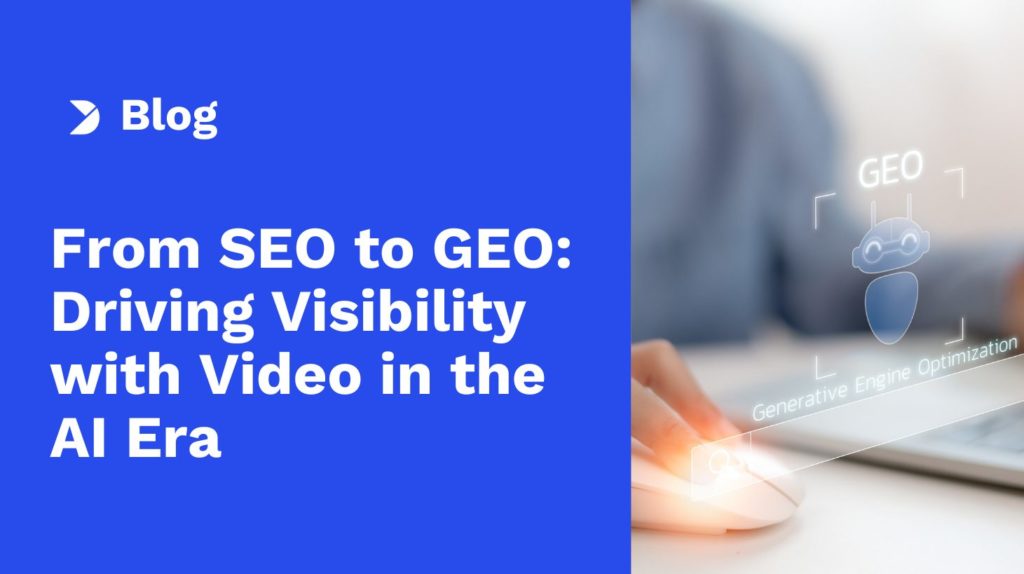From SEO to GEO: How Video Content Drives Visibility and Traffic in the AI Era
Search is going through a major shift. SEO used to mean optimizing for keywords and trying to rank on Google’s results pages. Now, with AI tools like Google’s SGE and ChatGPT, search is starting to look more like a conversation than a list of links.
Where once marketers fought for blue links on Google, we’re now entering an age where AI engines summarize, generate, and decide what users see. This shift is at the core of what’s now being called Generative Engine Optimization (GEO). Visibility is no longer just about clicks, but whether your content is chosen for AI-generated answers.
For marketers, especially in B2B SaaS, this brings a new challenge, but also a clear opportunity: video content. So, let’s look at how GEO works, why video is becoming so important in this space, and how to make sure your content is ready for this next phase of search.
Table of Contents
- SEO vs GEO: What They Really Mean Today?
- Why GEO Is Emerging Now
- How Video Content Plays a Central Role in GEO
- Top Tips for Optimizing Your Video Content for Generative Engines
- GEO Best Practices for B2B SaaS Companies
- Monetizing AI-Optimized Video Content
- Why Dacast Is the Ideal Platform for GEO-Optimized Video Content?
- FAQs
- Conclusion: Don’t Just Optimize for Search – Be the Answer
SEO vs GEO: What They Really Mean Today?

Traditional SEO has been around for a while, and at its core, it’s about helping your website get noticed by search engines like Google. The idea is pretty simple: you use the right keywords, organize your content well, get links from other sites, and make sure your pages have all the right metadata. If you do these things well, Google ranks your site higher on its search results pages (SERPs), and more people click through to your site.
SEO mostly focuses on keywords and links because Google used to work mainly by matching those keywords to user queries and then ranking pages based on relevance and authority. The goal was to get your website as close to the top of that list of blue links as possible.
But now, things are changing, so let’s define GEO.
Generative Engine Optimization (GEO) is the new kid on the block. Instead of just focusing on getting a website to rank in a list, GEO is about optimizing content so that AI-first search tools, like Google’s SGE (Search Generative Experience), ChatGPT, Perplexity, or other AI assistants, choose your content to answer questions directly.
The big difference is that these AI systems look beyond keywords. They want content that matches the intent behind a question, that can be summarized or chunked into quick answers, and that includes different types of media (text, video, images) altogether.
So, GEO means creating content that’s easy for these engines to understand, summarize, and pull into their conversational or multimodal responses. This is why multimodal content optimization and video SEO for large language models have become critical parts of generative search optimization.
In short, SEO was about getting noticed in a list. GEO is about getting picked as the actual answer.
Why GEO Is Emerging Now

People are no longer just typing keywords, but asking full questions and looking for really elaborate answers. Tools like ChatGPT and Perplexity have made this feel natural, and now platforms like Google and Microsoft are following that lead with their own generative search experiences.
And it’s not just users changing. In a recent survey, 72% of business leaders said they now use generative AI at least once weekly, nearly double the number compared to 2023. It’s a sign of how quickly generative AI is becoming a normal part of how teams work.
From Google to SGE and Bing Copilot
Google’s SGE, Microsoft’s Bing Copilot, and similar tools are making AI-first search more mainstream. These AI-powered engines don’t just give you links to content, but they summarize it, repackage it, and often give you what you need directly in the results.
This represents a major shift in the SEO vs GEO conversation since instead of ranking in a list of links, content now needs to be structured for AI search engine discoverability and be ready to get pulled into conversational or multimodal responses.
So, brands looking to optimize video for ChatGPT or Google SGE, for example, need to think about how their content can be interpreted and repurposed in these new formats.
Zero-Click Results Are Becoming the Norm
Another trend driving this shift is the rise of zero-click searches when users get what they need without ever leaving the results page. According to recent research, 80% of users now rely on zero-click results in at least 40% of their searches.
That means traditional click-based strategies are giving way to AI-powered search visibility, where content must be designed for answer inclusion and not just traffic. Rich content formats like video-enhanced content for search engines can be especially effective here.
GEO Is the Next Visibility Frontier
All of the above points to a clear shift in how brands compete for attention online nowadays. Whether you’re building out blog content or investing in B2B SaaS video marketing, your focus now needs to also include how to optimize video content for generative search engines.
And what is GEO in digital marketing, exactly? At its core, it’s a way to make sure your content can be selected, summarized, and surfaced by AI tools, not just ranked by algorithms. For SaaS companies, especially, GEO is becoming a key strategy for search engine optimization lead generation.
The shift is already happening, and the brands that adapt early will be the ones who stay visible, not just in search results, but in the answers themselves.
How Video Content Plays a Central Role in GEO
One of the biggest shifts in the generative searches is how AI engines are starting to prioritize multimodal content. Instead of pulling just text, they’re pulling from a mix of formats – text, images, and especially video. And that’s not just a UX feature, but one of the main ranking and visibility factors.
Why AI Favors Video
Video is one of the richest types of content you can create. It’s engaging, informative, and increasingly indexable. AI systems can now transcribe and summarize what’s said in a video, pick out key moments, and even pull clips to surface in response to a question. That means your video content isn’t just for your human audience anymore, but also for the AI.
So when a user asks ChatGPT something like “how does this software work?” or “which solution is better for X?”, the engine may not just pull from blog posts. If you’ve got a video that covers that topic clearly and is optimized properly, it could become part of the answer.
Supporting E-E-A-T with Video
So, how to get video content featured in AI answers? In a nutshell, it should support trust and credibility. Search engines use the E-E-A-T framework (Experience, Expertise, Authoritativeness, and Trustworthiness) to help evaluate content. And nothing communicates experience or authority like a real person demonstrating a product, walking through a concept, or sharing results on camera.
When your video content features actual use cases, real people, and clearly presented insights, it sends the right signals to both users and algorithms. It shows you know what you’re talking about, not just in theory, but in action.
Real-World Use Cases in B2B SaaS
In the context of B2B SaaS video marketing, there are a few standout ways video content can play directly into GEO performance:
- Product Walkthroughs: Short, targeted videos showing how a product works can be picked up and summarized by AI to answer how-to or product comparison queries.
- Explainer Videos: These are perfect for inclusion in AI-generated responses because they give quick, focused breakdowns of complex ideas, which is exactly the kind of content engines want to present to users.
- Video Testimonials: If your customer videos include specific comparisons, outcomes, or feature highlights, they may be embedded or referenced in AI-generated product summaries or reviews. These not only boost visibility in ChatGPT and SGE but also influence trust.
Top Tips for Optimizing Your Video Content for Generative Engines
If the future of search engine optimization is answer-focused and multimodal, video needs to be treated as a first-class content type. You probably want your video content for GEO to appear in AI-generated answers, so what you’ll need is more than just a good script and a clean recording. Generative engines prioritize structure, context, and clarity, both in how your video is built and how it’s positioned on the page. Here’s how to approach both sides.
Technical Optimization
Before AI can include your video in an answer, it needs to understand what’s in it. That means your content has to be formatted in a way that’s easy for large language models to parse and process.
1. Add Accurate Transcripts and Captions
AI models rely heavily on text to understand and summarize content. If your video doesn’t have a transcript or captions, you’re basically leaving the engine to guess what it’s about. Providing clean, accurate transcripts makes it easier for LLM-optimized video content to surface in relevant results.
2. Use Structured Data (Schema Markup)
To help AI engines understand your video content better, also use schema markup, especially VideoObject and Clip schema. This helps signal what your video is about, where key moments are, and how it relates to the rest of your content. It also makes it more likely to be included in rich search results or answer boxes.
3. Host on an SEO-Friendly Platform
Where you host your videos is another crucial technical factor. YouTube is great for reach, but platforms like Dacast give you more control over metadata, video SEO, and how your content is indexed. Dacast is a video hosting platform for AI search optimization and offers tools that help align your content with generative engine requirements, without ads or distractions.
4. Prioritize Mobile Performance
AI cares about what’s in the video, but it also cares about how fast it loads and how well it performs. Make sure your videos are mobile-optimized, lightweight, and deliver quickly. Engines tend to deprioritize content that’s slow or glitchy, especially in mobile-first indexing environments.
Content Strategy
Once your technical side is solid, it’s time to consider what your video is actually conveying and how it aligns with what users (and AI engines) are seeking. These best practices for B2B SaaS video SEO in the AI era can help you structure content in a way that is understood and surfaced by AI tools.
1. Match Topics to Searcher Intent
Your video topics should align with the questions people are asking in AI tools. Think long-tail, conversational queries – things like “how does this tool compare to X” or “best way to set up [software name] for onboarding.” The more directly your video aligns with a real question, the more likely it is to be surfaced in an AI-generated response, especially when you optimize video for Google SGE.
2. Embed in High-Authority Blog Content
AI engines evaluate content contextually. Embedding your videos in relevant, high-quality blog posts strengthens both the blog and the video’s visibility. It also provides LLMs with more surrounding content to pull from and connect to your video.
3. Use Chapters for Snippetability
Breaking your video into chapters or time-stamped segments helps AI tools understand the structure and extract only the most relevant content. If your video covers multiple questions or subtopics, clear chaptering makes it more useful and more likely to get featured.
4. Add FAQs, Summaries, and CTAs
Pair your videos with helpful on-page content like a written summary, frequently asked questions, or a clear call to action. This improves overall relevance and makes it easier for AI to contextualize your video, while it also boosts user engagement.
GEO Best Practices for B2B SaaS Companies
What is GEO in terms of strategy for B2B SaaS companies? Well, it definitely isn’t just a technical adjustment. In fact, it’s a strategic opportunity for B2B SaaS marketers to rethink how video fits into the search. Let’s take a look at some practical ways to future-proof your content and stay discoverable as AI-powered engines reshape how users find and engage with information.
1. Start with a GEO Audit
Before creating anything new, take a step back and assess how your existing content is showing up in AI-generated results. Use SGE Insights, Perplexity mentions checks, or even manual prompts in ChatGPT to check if your brand is being surfaced. Are your videos included? Is your messaging accurate? These audits help identify content gaps and give you direction on what to prioritize next.
2. Create “Answer-Ready” Video Assets
Nowadays, content that gets picked up is usually concise, clear, and purpose-built to provide answers. That means short-form explainer videos, expert soundbites, or product demo clips that directly respond to a specific query or need. These formats are easier for AI engines to summarize and repurpose, especially when aligned with conversational, long-tail search phrases.
3. Tell a Clear Problem-Solution Story
Your videos need to directly address pain points and offer real solutions. When someone asks, “How do I automate onboarding for new hires?” or “Which platform is best for secure video hosting?” the video should be able to provide the answer. Lean into narrative structure: what’s the problem, how does your product solve it, and what’s the outcome?
4. Track Your Presence in AI Tools
Make sure you monitor where your content appears in generative engines. While your tracking is still in the early stages, tools like Surfer AI Tracker, Semrush AI Toolkit, or Keyword.com Tracker can help you understand how your content is being used and whether your visibility is improving.
5. Build Video-First Landing Pages
Instead of tucking your videos into the bottom of blog posts, consider designing landing pages where video is the focal point. These pages can serve both human visitors and AI engines at once, especially if they include transcripts, supporting text, schema markup, and clear context.
6. Tie Video to First-Party Data Capture
If your video content is doing the work of educating and converting, make sure you’re getting something in return. Use video as a lead generation tool – gate demos, add in-video forms, or pair viewing events with follow-up automation. Platforms like Dacast make it easy to combine video playback with first-party data capture and help you bridge discoverability with measurable impact.
Monetizing AI-Optimized Video Content

Once your video content is discoverable by AI engines, it’s no longer just a brand awareness tool. It can easily become a direct revenue driver or lead generator. Whether it’s being pulled into a ChatGPT answer or summarized by Google SGE, that visibility creates new touchpoints for conversion. Make sure to use the momentum.
Turn Visibility Into Value
Videos that are picked up by AI tools often align with high-intent questions like “how does this product work?” or “what’s the best platform for X use case?” If your video is the one that answers those questions, you’re already in a strong position to move viewers from discovery to action.
Depending on your goals, these videos can work in a few different ways:
- Lead generation – Gated demos or tutorials can bring in qualified prospects.
- Customer education – Videos explaining use cases or best practices help with retention and onboarding.
- Product conversion – Short explainers or testimonials shown in search answers can move someone closer to a buying decision without ever landing on your homepage.
Dacast: Monetization Without Compromising Optimization
If you’re ready to monetize, you’ll need the right infrastructure. Platforms like Dacast make it easy to turn videos into revenue without sacrificing search visibility or user experience. You can:
- Add paywalls to premium content or training videos.
- Offer subscriptions for gated video libraries or ongoing content series.
- Deliver video without ads or third-party branding, ensuring your content stays on-message and GEO-optimized.
What sets Dacast apart is its ability to do all this while maintaining control over metadata, structure, and delivery, so your monetized videos can still show up in generative engine results when it matters most.
Why Dacast Is the Ideal Platform for GEO-Optimized Video Content?
If you’re investing time and resources into creating video content for Generative Engine Optimization (GEO), your hosting platform can’t be an afterthought. Dacast is built with exactly this challenge in mind, giving you the tools to control how your videos are delivered, discovered, and monetized across both traditional search and AI-driven experiences.
Full SEO Control, Without Compromise
Dacast’s HTML5 video player gives you full control over how your content appears in search. From metadata to schema markup, you can optimize every element to ensure your videos are clearly understood by AI engines and indexed adequately for GEO.
Built-in Accessibility and Structure
The platform supports closed captions, transcripts, and structured data, which are key to making sure AI models can parse, summarize, and surface your video in answer-based formats. Whether it’s a tutorial, demo, or explainer, Dacast helps make that content AI-readable by default.
Reliable, Fast, and Global Delivery
With CDN-backed video streaming, your videos are delivered quickly and securely to viewers around the world. That’s important not just for user experience, but also for performance signals that AI engines take into account when evaluating content.
No Branding, No Distractions
Unlike mainstream platforms, Dacast lets you embed your videos without any third-party branding or ads. That means your video always reflects your message, and no competing links or irrelevant content dilute the experience.
Real-Time Analytics for GEO Performance
Want to know how your video content is performing, not just with users, but in AI ecosystems? Dacast offers detailed analytics, including engagement tracking and performance metrics that can help you evaluate your strategy for GEO-tailored content and make the right adjustments.
Flexible API for Full Integration
Whether you’re embedding videos into product walkthroughs, onboarding flows, or customer support portals, Dacast’s API tools give you the flexibility to integrate video across your entire digital experience.
FAQs
How are SEO and GEO different?
SEO is about ranking content in traditional search results, mostly based on keywords, links, and structured metadata. GEO is about getting your content on the radar of AI algorithms. Instead of fighting for a top spot on a list of links, you’re aiming to be the content that’s quoted, summarized, or recommended directly in an AI-generated answer.
Why is video better than text for AI-generated answers?
Video adds depth, context, and trust in ways plain text often can’t. AI tools are increasingly trained to interpret multimodal content, and a well-structured video, especially with transcripts, captions, and schema, can be summarized, clipped, or embedded into an AI response. It also supports E-E-A-T, which boosts your credibility for users and algorithms.
Do I need to reformat my old SEO content for GEO?
In many cases, yes. Traditional SEO content might be too long, too keyword-heavy, or not structured for AI parsing. To adapt for GEO, focus on clarity, intent-matching, and structure. Add summaries, transcripts for any embedded video, and answer common questions in a direct way that AI can easily interpret and repackage.
Is there a way to know if AI tools are using my video content?
There’s no perfect tool yet, but some platforms offer early tracking. Tools like Semrush’s AI Toolkit, Keyword.com’s AI Rank Tracker, and Perplexity brand monitoring add-ons can help you track whether your videos or brand are appearing in AI-generated answers. You can also test manually by prompting tools like ChatGPT or SGE with relevant queries and checking what content gets pulled in.
Will hosting a video on YouTube still work for GEO?
YouTube content can still be picked up by generative engines, but you won’t have much control over how it’s indexed or presented. Plus, you’re competing with a flood of unrelated content and third-party branding. Hosting on a platform like Dacast, where you control the metadata, structure, and delivery, gives you a much stronger position for GEO optimization.
How often should I update my video content for GEO relevance?
It depends on the topic you’re covering, but if the information changes, your video should too. For high-competition queries or fast-moving topics (like SaaS features or tech trends), updating videos every 6–12 months helps keep them accurate and GEO-relevant. Also, consider refreshing transcripts, summaries, and schema markup when content is revised.
Conclusion: Don’t Just Optimize for Search – Be the Answer
Generative Engine Optimization (GEO) isn’t replacing SEO – it’s extending it. As search engines evolve from static lists to AI-generated answers, visibility now depends on whether your content can be surfaced, summarized, and trusted in that new format.
This is where video makes the difference. It informs, builds trust, conveys experience, and helps your content stand out across platforms like Google SGE, ChatGPT, and Perplexity. For B2B SaaS marketers, video is a real competitive advantage.
And with Dacast, you have everything you need to deliver GEO-ready video content that performs. From customizable hosting to full metadata control and ad-free delivery, the platform is designed to help you stay ahead as AI search becomes the norm.
Start your free 14-day trial with Dacast and explore every feature – captions, transcripts, analytics, schema support, and more, all included and ready to scale with you.
Want more live streaming insights, feature tips, and exclusive updates? Connect with the Dacast community on LinkedIn for exclusive updates, streaming strategies, and product news.
 Stream
Stream Connect
Connect Manage
Manage Measure
Measure Events
Events Business
Business Organizations
Organizations Entertainment and Media
Entertainment and Media API
API Tools
Tools Learning Center
Learning Center Support
Support Support Articles
Support Articles